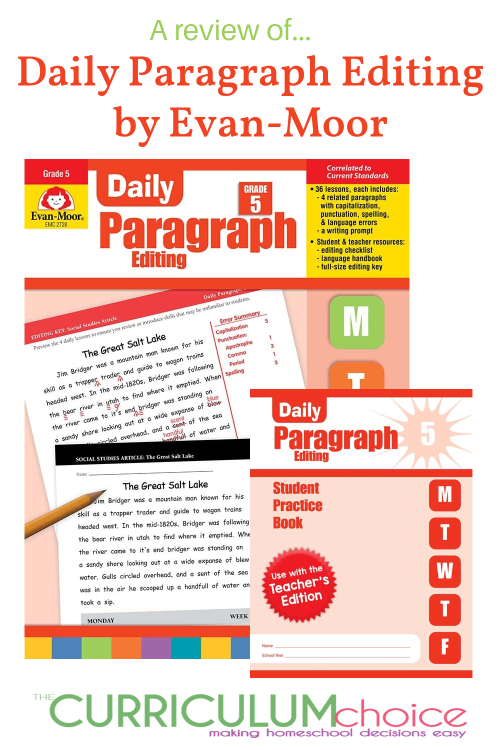Daily Paragraph Editing is a series of language arts workbooks by Evan-Moor. Editing exercises are a great way to teach grammar and usage.
Why should you give your children regular editing and proofreading exercises as part of their language arts studies?
- Editing exercises teach them how read critically for errors. Hopefully, those skills will carry over into their own writing as they go through the drafting, revising, and editing steps of the writing process.
- Editing exercises are the best way to teach grammar and usage – in the context of real writing, versus the forced situation of a textbook activity.

In an ideal world, mom would select a literature passage from something her child is studying, make some changes, and have the child find the errors. But few of us have time to do that each day. That’s why I love Daily Paragraph Editing by Evan Moor.
Daily Paragraph Editing by Evan-Moor
Daily Paragraph Editing is available in printed format or ebook format. You also have the option of a less expensive Student Workbook if you feel confident that you don’t need the answer keys. There is a book for each grade 2nd-6th.
Each book has 36 weeks of lessons, each week with four paragraphs, all centered on a certain theme. The themes vary from academic to daily topics, for example baseball, eating pizza, George Washington Carver, or John Muir. Each paragraph takes up half of a page, and the suggested corrections are on a separate page. On the student’s portion, there is a hint telling them what type of corrections to especially watch for. But the errors are not limited to that one thing. If you want to know exactly what errors to look for, refer to the Skills Scope and Sequence chart offered in each Daily Paragraph Editing volume. On the fifth day of the week, the student can use the list of weekly writing topics, each of which is a continuation of the weekly theme.
Because you’re doing a short editing practice each day, even these toughest punctuation rules are going to finally sink in through the repetition. And for some reason, students find it more enjoyable to look for capitalization problems in some one else’s work rather than to learn a capitalization lesson. But you can use the editing practice as a springboard to those types of mini lessons.
Suggestions for Using Daily Paragraph Editing
- Give the child the passage, and have him read it. Reading aloud is preferable, because doing so often helps him catch errors, especially with punctuation, fragments, and run-on sentences.
- Make sure he understands the passage before making the corrections. Take time to discuss any new terms or ideas.
- Give him time with a “red pen” and the passage, using standard proofreading marks to indicate his corrections directly onto the passage. (The book even includes a chart of proofreading marks at the front of the book.)
- Check his corrections against the ones on the answer key. I actually go sentence by sentence, making my daughter tell me what correction she made and why. If she doesn’t know why, then we refer to a writer’s handbook for the grammar or usage rule. The book itself includes a short language handbook with rules for writing and editing. This is a great opportunity for a mini grammar lesson.
- You can record any errors that were missed on the Skills Scope and Sequence chart. As you see patterns emerging, you can stop and do more intensive grammar or mechanics lessons.
Remember that the corrections are not always written in stone. English is flexible, and there are often many ways to correct a problem. So be willing to consider alternative corrections. As long as the passage is free from error, the student has successfully edited it.
More Homeschool Language Arts Resources

The Ultimate Guide to Homeschool Language Arts Curriculum – Looking for a Homeschool Language Arts curriculum that suits your family’s needs? Need just a spelling or writing program? This list is sure to have what you are looking for! This list contains full homeschool language arts curricula, as well as resources for reading/literature, writing, spelling, grammar and handwriting.
~ Originally posted August 2009, written by Jimmie


Great review. I like the idea of teaching grammar rules through a natural and fun approach. I’ll definitely consider this when we begin focusing more on grammar next year. Thanks for introducing me to this resource!
.-= Shannon´s last blog ..Windmills and a Keelboat =-.
I love these too! I used it when I taught public school, and will definitely use it again when my kids are old enough!
.-= Laura´s last blog ..4th of July! =-.
excellent review, jimmie. i have often been frustrated by teaching the same grammar concepts on a regular basis. you are right, though. it does sink in with repetition!